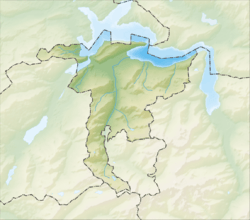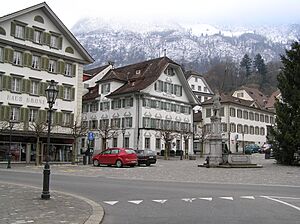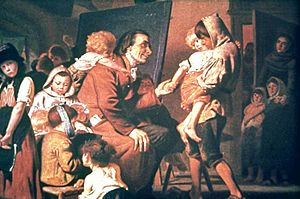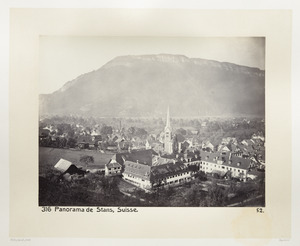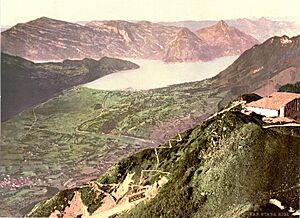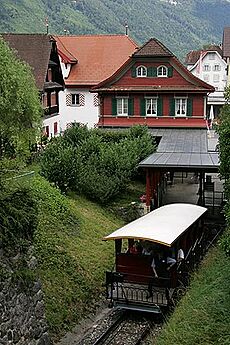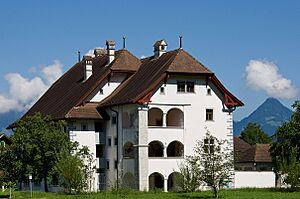Stans facts for kids
Quick facts for kids
Stans
|
||
|---|---|---|
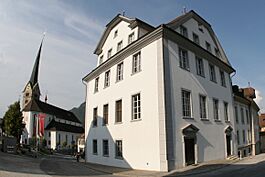 |
||
|
||
| Country | Switzerland | |
| Canton | Nidwalden | |
| District | n.a. | |
| Area | ||
| • Total | 11.08 km2 (4.28 sq mi) | |
| Elevation | 452 m (1,483 ft) | |
| Population
(Dec 2020 )
|
||
| • Total | 8,171 | |
| • Density | 737.5/km2 (1,910.0/sq mi) | |
| Postal code |
6370
|
|
| Surrounded by | Buochs, Dallenwil, Ennetbürgen, Ennetmoos, Oberdorf, Stansstad | |
Stans is the capital city of the canton of Nidwalden in Switzerland. It's a beautiful place with a rich history.
The main language spoken in Stans is a local type of Alemannic Swiss German. However, the official language is German.
Contents
Exploring the History of Stans
Stans is one of the oldest towns in the Nidwalden valley. People first lived here around 200 BC. During the time of the Roman Empire, there isn't much proof of a settlement. However, the name Stans comes from a Latin word, stagnum, which means a pool.
Early Settlements and Churches
Around the 7th or 8th century, a group of people called the Alamanni settled in this area. These Christian Alamanni built the first church in Stans around 750 AD. This old church was the main church for the whole Engelberg Valley. It was made bigger many times before a new church, St. Peter and Paul, replaced it in 1647.
Stans was first mentioned in official records in 1124. By 1291, Stans was already the capital of the area known as Unterwalden nid dem Kernwald. This area later became the half-canton of Nidwalden. This was when Unterwalden joined Uri and Schwyz to form what is now Switzerland.
The Legend of Arnold von Winkelried
In 1386, during the Battle of Sempach, a soldier from Stans named Arnold von Winkelried is famous for a brave act. The story says he threw himself onto the sharp pikes of the Habsburg army. This act supposedly helped the Swiss win the battle.
However, historians are not sure if he really existed or died in this way. The first time this selfless act was mentioned was over 150 years after the battle. Also, a man who might have been Arnold was part of a lawsuit in 1389. Even so, the legend is very important in Stans. There is a monument and a house in town dedicated to him.
Peace in Stans: The Stanser Verkommnis
After the Swiss won the Burgundian Wars, the country almost had a civil war. The cities wanted more of the money because they sent more soldiers. The country areas didn't like this. Leaders from each canton met in Stans in 1481 to solve the problem.
They couldn't agree, and war seemed likely. So, they asked a local wise man, Niklaus von der Flüe, for advice. He sent a secret message to the leaders. We don't know what the message said, but it calmed everyone down. This led to an agreement called the Stanser Verkommnis. Because of this agreement, Fribourg and Solothurn joined the Swiss Confederation.
Protecting the Town
During the Middle Ages, Stans had seven protective towers. But the town never built a wall to connect these towers and surround itself.
In 1713, a fire destroyed two-thirds of the town. After the fire, new rules made sure the village square (Dorfplatz) stayed open and clear. The large, open square with its Baroque houses and the town hall (Rathaus) looks the way it does today because of this fire and the rebuilding that followed.
In 1798, French soldiers attacked Stans. This happened because Nidwalden did not want to accept the new constitution of the Helvetic Republic. Many children lost their parents in this event. A teacher named Johann Heinrich Pestalozzi gathered these orphans to start his first school. He used the Convent of St. Klara (built 1621–1625) as a school building. However, the French Army needed the building the next year, and the school had to close.
After Napoleon's rule ended in 1814, Nidwalden tried to go back to its old government style. This meant the canton would own lands and people. Stans and Nidwalden only gave up these lands when federal troops marched into the city. Stans and Nidwalden later joined the Sonderbund in 1845 and were part of the 1847 Sonderbund War.
Modern Changes
In the 20th century, new technology and ways to travel changed Stans. In 1893, Stans was connected to Lucerne by a steam ferry and rail. In 1964, the Lucerne-Stans-Engelberg railway opened. In 1966, the A2 motorway was built. This highway is Switzerland's main road from Basel in the north to Chiasso in the south.
The open-air assembly, called the Landsgemeinde, was held in Stans every year until it was stopped in 1997.
Geography and Climate of Stans
Stans covers an area of about 11.08 km2 (4.28 sq mi). A large part of this land (43.7%) is used for farming. Over a third (36.5%) is covered by forests. About 17% of the area has buildings and homes. Less than 2.6% is unproductive land like mountains or rivers.
The highest point in Stans is on the Stanserhorn mountain, at 1,819 m (5,968 ft) above sea level. The lowest point is at Fronhofen, which is 438 m (1,437 ft) high. The village square (Dorfplatz) is at an elevation of 452 m (1,483 ft).
Weather in Stans
Stans gets rain on about 137.7 days each year. On average, it receives 1,224 mm (48.2 in) of rain. August is the wettest month, with about 166 mm (6.5 in) of rain over 13.6 days. June has the most rainy days (14.2), but with slightly less rain (156 mm (6.1 in)). January is the driest month, with about 65 mm (2.6 in) of rain over 13.6 days.
People and Population in Stans
Stans has a population of 8,171 people (as of 31 December 2020). In 2007, about 9.4% of the people living in Stans were from other countries. Over the past 10 years, the population has grown by 13.2%.
Most people in Stans (91.6% in 2000) speak German. Italian is the second most common language (2.0%), followed by Serbo-Croatian (1.2%). In 2008, about 48.6% of the population was male and 51.4% was female.
In 2000, there were 2,816 households in Stans. About 65.2% of these households had only one or two people. About 7.2% were large households with five or more members.
Education and Politics
In Stans, about 75.2% of people aged 25–64 have finished either advanced high school education or higher education. This includes university or a Fachhochschule (a type of professional university).
In the 2007 federal election, the most popular political party was the FDP. It received 88% of the votes. Most of the remaining votes went to smaller local right-wing parties (10.8%).
Historical Population Data
Here's how the population of Stans has changed over time:
| Year | Total People | Swiss Citizens | Foreign Citizens |
|---|---|---|---|
| 1970 | 5,445 | 5,022 | 423 |
| 1980 | 5,660 | 5,340 | 320 |
| 1990 | 6,171 | 5,697 | 474 |
| 1995 | 6,468 | 5,896 | 572 |
| 2000 | 6,914 | 6,349 | 665 |
| 2005 | 7,512 | 6,875 | 637 |
| 2006 | 7,556 | 6,936 | 620 |
| 2007 | 7,577 | 6,909 | 668 |
| 2008 | 7,784 | 7,050 | 734 |
Economy and Work in Stans
Stans has a low unemployment rate of 1.27%. This means very few people who want to work are unable to find jobs.
As of 2005, here's how people in Stans were employed:
- 89 people (1.2%) worked in the primary economic sector. This includes jobs like farming. There were about 32 businesses in this area.
- 2,463 people (34%) worked in the secondary sector. This includes jobs like manufacturing and construction. There were 113 businesses in this sector.
- 4,601 people (65%) worked in the tertiary sector. This includes jobs in services, like shops, hospitals, and offices. There were 496 businesses in this sector.
Getting Around Stans
Stans has its own train station, called Stans station. It's on the Luzern–Stans–Engelberg line. The Lucerne S-Bahn S4 train comes twice an hour from Lucerne. Also, an hourly train service between Lucerne and Engelberg stops in Stans.
Must-See Sights in Stans
The Stanserhorn Mountain
The local mountain, the Stanserhorn, is 1,898 m (6,227 ft) tall and is a popular place for tourists. You can reach it by taking one of Switzerland's oldest mountain railways, the Stanserhornbahn (built in 1893). You can also take a modern cable car.
The Stanserhornbahn was first built as a special kind of train called a rack and pinion railway. It had three separate parts. In 1970, the top part was destroyed by a fire caused by lightning. In 1975, the damaged top section and the middle section were replaced with an aerial cable car.
At the top of the Stanserhorn, there's a restaurant called Rondorama. It was built in 2001 and it slowly spins around! On a clear day, you can see almost 100 km (62 mi) from the top. This view includes 10 Swiss lakes and even the Black Forest in Germany. There's also a short walking path around the peak. You might even see some Marmots, which are kept near the trail.
The Village Square: Dorfplatz
After the big fire in 1713, the village square (Dorfplatz) was completely rebuilt. It got its current look in 1715, following plans by Josef Aebi and Ludwig Gassmann.
Today, the square has the Winkelried fountain and a sculpture called Der Tod und das Mädchen (Death and the Maiden). The Winkelried monument was carved from Carrara marble in Rome. It was then shipped to Stans in 1865. This monument is in a Gothic Revival style and was carved by Ferdinand Schlöth. The "Death and the Maiden" sculpture was made by Rudolf Brem.
St. Peter and Paul Parish Church
The main church in Stans, St. Peter und Paul, was built between 1641 and 1647 by architect Jakob Berger. The church was built in an early-Baroque style. However, its bell tower is much older, from the Romanesque period.
This church has three naves and was built south of an even older church. The old bell tower is from that previous church. Inside, the church is decorated in white, gold, and black. The simple decorations inside come from Lombardy, and the altar figures were made by Georg Allhelg. Next to the church is a two-story chapel and a bone house (ossuary) for the nearby Capuchin monastery.
Capuchin Monastery
A Capuchin monastery was started in Stans in 1583 by Melchior Lussy. He was a delegate to the Council of Trent. At first, people didn't like the Capuchin monks' simple clothes and beards. In 1777, the monks opened a Latin school. This school was closed from 1798 to 1803 during the Helvetic Republic.
The monks built the Kollegium St. Fidelis in 1895. The canton bought it in 1988. The monastery church was built in 1683 and fixed up in 1980. In 1956, a memorial plaque for Melchoir Lussy was placed near the monastery gate.
Convent St. Klara
The Convent St. Klara was founded by Katharina and Maria Gut in 1618. The buildings were constructed from 1621 to 1625. In 1799, Heinrich Pestalozzi used these convent buildings for his orphanage and school.
The convent church (built in 1723) is a simple building. It has a fancy altar by Johann Ritz and a special altar painting by Johannes Brandenburg. The church was renovated in 1980. A path from the convent cemetery leads to the nearby Capuchin monastery.
The Winkelriedhaus
Part of the Winkelriedhaus (Winkelried House) was once home to the Winkelried family. However, Arnold von Winkelried (if he was real) did not live in this specific house. The oldest part of the building dates back to the mid-15th century.
This early house was a very tall and large half-timbered building. It was well-known throughout central Switzerland. The Winkelried family didn't own it for very long. In 1541, the Lussy family bought the house. Under Melchior Lussy, the old Gothic building was updated over 50 years into a much bigger, Renaissance-style mansion.
In 1766, the Chief Magistrate, Jost Remigi Trachsler, bought the house. For much of the late 18th century, he renovated the Winkelriedhaus. He added beautiful rococo frescos (wall paintings) to the house. In 1815, the Kayser family bought the house. They owned it until 1974, when they gave it to the canton. It was restored from 1983 to 1991. Since then, it has been the Museum für Kultur und Brauchtum (Museum for Culture and Customs).
The Salzmagazin
The Salzmagazin (which means "Salt storage house") was built in 1700. It was originally used to store grain and salt for the community. Since then, it has been used for many other things, including a theater, a high school, and finally, a museum.
You can see the coat of arms of the builder, Nicolaus Keiser, on the north side of the building. There are also two lions with the Nidwalden shield and a two-headed eagle.
Statue of Deschwanden
In the front garden of what used to be the Nidwaldner Kantonalbank, there is a statue. It was made by Swiss sculptor August Stanser Blaesi (1903–1979). The statue was put up in the autumn of 1933 to remember a local artist named Melchior Paul von Deschwanden (1811–1881).
Deschwanden was a very important and busy religious painter of his time. He studied in Munich, Germany. His paintings were sent to Catholic churches as far away as Annapolis, Maryland, and Covington, Kentucky. Some of his students included Adalbert Baggenstos (1863–1897) from Stans, and the Swiss-born American portrait painter Adolfo Müller-Ury. Deschwanden died in Müller-Ury's arms in February 1881.
Famous People from Stans
- Melchior Lussy (1529 in Stans – 1606), a Swiss Catholic leader.
- Melchior Paul von Deschwanden (1811 in Stans – 1881), a religious painter.
- Gustave Lussi (1898 in Stans – 1993), a famous figure skating coach.
- Hans von Matt (1899–1985), a painter and sculptor, born and died in Stans.
- Peter von Matt (born 1937), a language expert and author, grew up in Stans.
- Urs Odermatt (born 1955 in Stans), a film director and author.
- Monika Hess (born 1964 in Stans), a former alpine skier who competed in the 1984 Winter Olympics.
- Bruno Amstad (born 1964 in Stans), a singer known for improvisation and jazz music.
- Joseph Odermatt (born around 1965 in Stans), a pope of the Palmarian Catholic Church.
- Rochus Lussi (born 1965 in Stans), an artist, art teacher, and wood sculptor.
- Seppi Hurschler (born 1983 in Stans), a Nordic combined skier who competed in three Winter Olympics.
- Nicole Riner (born 1990 in Stans), a retired tennis player.
- Ayla Huser (born 1992 in Stans), a badminton player.
- Zoël Amberg (born 1992 in Stans), a professional racing driver.
See also
 In Spanish: Stans para niños
In Spanish: Stans para niños




